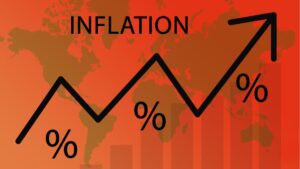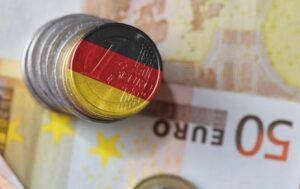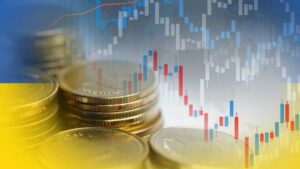
Consumer price growth in Ukraine slowed to 0.7% in February 2023 from 0.8% in January, returning to the level of December last year, the State Statistics Service (Gosstat) said on Friday. According to its data, 1.6% inflation was recorded in February-2022, so in annual terms in February-2023 it fell to 24.9% from 26% in January and from 26.6% in December last year.
Core inflation in the past month fell to 0.5% from 0.7% in January and 0.8% in December 2022, the Gosstat said.
With core inflation at 1% in February 2022, year-over-year core inflation also fell to 22.7% in January from 23.3%, just above last year’s 22.6%.
In the consumer market in February, prices for food and non-alcoholic beverages have increased by 1.5%. Vegetables went up most of all (by 13.9%). Fruit, poultry, fish and fish products, bread, milk and dairy products, pasta and soft drinks rose by 1.4-0.4%. At the same time, processed cereal products, eggs, rice, bacon, beef, pork and sunflower oil went down in price by 2.3-0.4%.
The prices of alcoholic beverages and tobacco products rose by 1.1%, including tobacco products – by 1.4% and alcoholic beverages – by 0.9%.
Clothing and footwear fell in price by 3.2%, including clothing by 3.2% and footwear by 3.1%.
An increase in prices in the health sector by 0.8% was primarily due to a 1.6% increase in the cost of outpatient services and hospital services.
Transport prices fell by 1.7% due to the decline in fuel and lubricants by 5.3%, as well as train fares by 1.5%.
As it was reported in January, the National Bank of Ukraine improved its inflation forecast for this year from 20.8% to 18.7%, including down to 23.6% in the first quarter and to 18.7% in the first half of the year.
The government this week also reported that its inflation forecast for the current year has been lowered to 24% from 28%.

The National Bank of Ukraine (NBU) has improved its inflation forecast for 2023 to 18.7% (the October forecast was 20.8%), as the market expected, the regulator’s press service said Thursday.
“The NBU forecasts a slowdown in inflation to 18.7% in 2023. This will be facilitated by continued tight monetary conditions, lower global inflation and weaker consumer demand amid power outages,” the statement explained.
It is pointed out that the receipt of announced volumes of international aid and joint actions of the NBU and the government on boosting the market of domestic debt attracting will allow to avoid emission financing of the budget deficit and to balance the currency market.
The regulator expects that inflation will slow down more quickly in the years to come due to lower security risks, a full recovery in logistics and an increase in yields.
The NBU, in particular, predicts that it will fall to 10.4 percent in 2024 and 6.7 percent in 2025.
“The main contribution to inflation in these years will have an administrative component due to the need to bring tariffs for housing and communal services to market levels,” the central bank explained.
It is noted that over the past three months the annual inflation rate has remained almost unchanged.
Stabilization of inflationary pressure was facilitated by the de-occupation of territories, the expansion of food supply, measures taken by the NBU and weaker consumer demand amid Russia’s energy terror.
At the same time, price pressures remain significant due to the aftermath of the war, including the destruction of enterprises and infrastructure and disruption of production and supply chains. Inflation expectations remained elevated despite stabilization.

Consumer price growth in Ukraine in December 2022 remained at the level of November – 0.7%, compared to 2.5% in October, 1.9% – in September and 1.1% – in August, returning to the level of July, the State Statistics Service (Gosstat) said on Tuesday.
Last December, there was a 0.6% inflation rate, so in annual terms it was 26.6% for the year as a whole, compared to 26.5% in November.
Core inflation fell to 0.8% last month from 1.3% in November and 1.9% in October, 2.4% in September and 2.1% in August.
Overall for the year, core inflation was 22.6%, the Gosstat said.
In mid-October, the National Bank kept the inflation forecast for 2022 at 30%, while the government improved it from 30.1% to 29.3% in late October.
The prices of food and non-alcoholic beverages in the consumer market rose by 0.7% in December. Oil, milk and dairy products, bread, fruit, vegetables, soft drinks, fish and fish products rose by 2.5-0.9%. At the same time, processed cereal products, eggs, sugar, poultry, bacon, pork and rice went down in price by 2.7-0.1%.
Prices for alcoholic beverages and tobacco products increased by 0.7%, which is associated with an increase in the price of tobacco products by 1.7%.
Clothing and footwear became cheaper by 2.6%, including clothing by 3.0% and footwear by 2.4%.
A 0.9% increase in health care prices was primarily due to a 1.3% increase in the price of outpatient services and a 1.0% increase in the price of pharmaceutical products.
Transportation prices rose 1.6% primarily due to a 3.1% increase in the price of fuel and lubricating oils.
As reported, Ukraine’s inflation rate in 2021 rose to 10% from 5% in 2020 and 4.1% in 2019, and the base rate rose to 7.9% from 4.5% a year earlier.

The growth of consumer prices in Ukraine in October 2022 accelerated to 2.5% from 1.9% in September, 1.1% in August and 0.7% in July, the State Statistics Service (Gosstat) reported on Thursday.
In October last year, inflation of 0.9% was recorded, so in annual terms, in October this year, it rose to 26.6% from 24.6% in September, 23.8% in August, 22.2% – according to the results of July and 21.5% – according to the results of June.
Core inflation fell to 1.9% last month from 2.4% in September and 2.1% in August.
Since the beginning of this year, over ten months, consumer prices in Ukraine have increased by 24.8%, while core inflation was 20.1%, the State Statistics Service said.
In mid-October, the National Bank kept its inflation forecast for 2022 at 30%, while the government improved it from 30.1% to 29.3% at the end of October.
In the consumer market in October, prices for food and non-alcoholic beverages rose by 4.2%. Most of all (by 60.5%) eggs have risen in price. Prices for lard, vegetables, fruits, meat and meat products, soft drinks, fish and fish products, cheeses, butter, and milk increased by 11.3-2.3%. At the same time, grain processing products fell in price by 4.8%.
Prices for alcoholic beverages and tobacco products increased by 0.9%, incl. for tobacco products – by 1%, alcoholic beverages – by 0.8%.
Clothing and footwear rose in price by 1.9%, including footwear – by 2.1%, clothing – by 1.7%.
The 1.2% increase in prices in the healthcare sector was primarily due to the increase in the cost of hospital services by 1.8% and outpatient services – by 1.6%.
Transportation prices rose by 0.8%, mainly due to a 1.5% increase in vehicle prices. At the same time, fares in railway passenger transport fell by 5.1%.
As reported, in 2021 inflation in Ukraine rose to 10% from 5% in 2020 and 4.1% in 2019, while core inflation rose to 7.9% against 4.5% a year earlier.

Consumer prices in Germany, harmonized with EU standards, rose by 11.6% in annual terms in October, according to preliminary data from the country’s Federal Statistical Office (Destatis).
Inflation accelerated from 10.9% in September and again renewed its historical maximum.
Analysts polled by Trading Economics expected inflation to remain at 10.9% on average.
Consumer price growth slowed to 1.1% month-on-month from 2.2% in September. Experts on average predicted an increase of 0.5%.
Inflation, calculated by German standards, in October accelerated to 10.4% in annual terms – the highest since December 1951, compared with 10% a month earlier. On a monthly basis, it slowed down to 0.9% from 1.9%.
Inflation in Germany is fueled by a weaker euro, an energy crisis and ongoing problems in supply chains.
Energy prices in the country rose by 43% in October, food prices rose by 20.3%, and the cost of services increased by 4%.
The final data on inflation in Germany for October will be published on November 11th.

Ukrainian businesses in the third quarter worsened expectations of inflation over the next 12 months to 25.2% from 21.7% in the previous quarter and worsened expectations of hryvnia devaluation to 41.93 UAH/$1 from 36.06 UAH/$1.
According to the results of the regular quarterly survey of business expectations of enterprises in the country, released on the NBU website on Monday, the business expectations index (BIE) of enterprises rose to 79.5 percent from 72.6 percent in the previous quarter, indicating a softening of negative economic sentiment.
The central bank explained that the increase was due to improved estimates for all components of the index, most notably for total sales of own-produced goods.
It is noted that companies expect a slowdown of decline in production of goods and services in Ukraine in the next 12 months: the balance of responses is “minus” 37.9% in the third quarter compared to “minus” 48.7% in the second quarter of 2022.
The majority of companies (52.4%) expect their financial and economic situation to remain unchanged in the next 12 months, 31.3% expect it to deteriorate and 16.2% expect it to improve.
According to the report, 31.7% of respondents expect a reduction in sales volumes (compared to 43% in the second quarter), including in foreign markets, while 44.4% expect the volumes to remain unchanged.
According to the survey, 32.9% of enterprises intend to reduce the number of employees, 59.7% – leave the staff unchanged.
Reduced expectations of companies to increase salaries of workers in the next 12 months: 41.4% of respondents plan to increase wages, 50.8% – to keep at current levels, 7.9% – to reduce.
The percentage of companies that plan to attract foreign investment fell to 22.2% from 24.1%, according to the survey.
Loans in local currency are planned to attract 86.3% of companies, while in the previous quarter this proportion was 84.6%.
A total of 642 companies from 21 regions participated in the survey of business expectations, which was conducted between 1st and 31st of August 2022. Among those surveyed, 18.2% were companies in the processing industry, 21.2% in wholesale and retail trade, 14.6% in agriculture, 13.2% in transport and communications, 6.4% in mining, 5.1% in electricity and water supply, 3% in construction and 18.2% in other sectors.
The EDI is an aggregate indicator regarding the expected development of enterprises in the next 12 months. Calculated based on the results of surveys of enterprises as an arithmetic means of the balances of responses regarding the financial and economic situation of enterprises, total sales of own production, investment spending on construction works, investment spending on machinery, equipment and inventory, and the number of employees.
An index value of more than 100 indicates an advantage of positive economic sentiment in society, below 100 – negative economic sentiment.